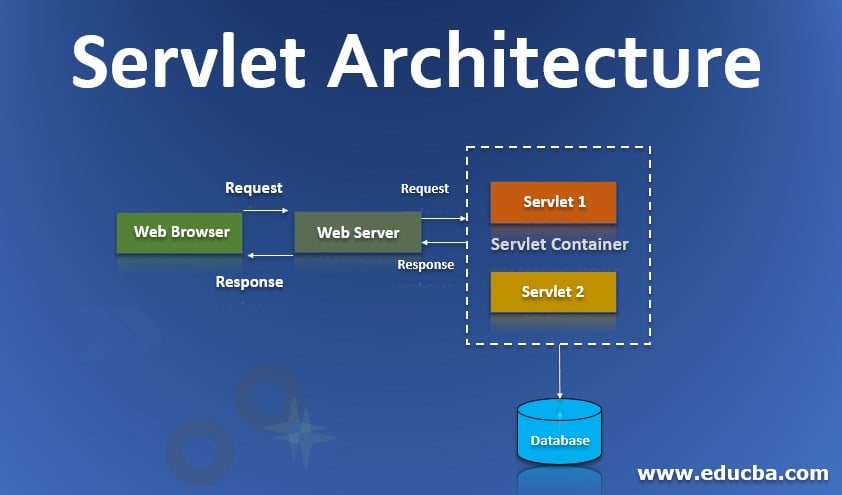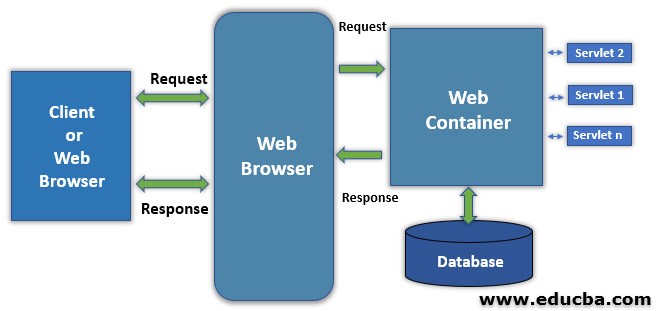Updated June 27, 2023

Introduction to Servlet Architecture
Servlet architecture comes under a java programming language to create dynamic web applications. Mainly servlets are used to develop server-side applications. Servlets are very robust and scalable. Before introducing servlets, CGI (common gateway interface) was used. Servlets facilitate client request and response tasks dynamically. They execute various functions, such as
- Control the flow of the application.
- Generate dynamic web content.
- Server-side load balancing.
- Implement business logic.
There are two types of Servlets- 1. Generic Servlets 2.HTTPServlets.servlets can be created in three ways (i)Implementing Servlet Interface, (II)Extending Generic Servlet. (III)Extending HTTPServlet. Three life cycle methods available with servlets are init(), service(), and destroy(). Every servlet should override these methods.
Components of Servlet Architecture
Below is the diagram to show how components work on servlet architecture.
1. Client
In this architecture, the web browser acts as a Client. Client or user connected with a web browser. The client is responsible for sending requests or HttpRequest to the web server and processing the Web server’s responses.
2. Web Server
The web server controls how web users access hosted files and is responsible for processing user requests and responses. Here server is software it understands URLs and HTTP protocol. Whenever a browser needs to host a file on the web server, it processes a client request using an HTTP request; if it finds the requested file, it sends it back to the browser through HTTP Response. Static web servers send the file as it is, while dynamic web servers update the server-hosted file before sending it to the browser.
3. Web Container
A web container is a web server component that interacts with Java servlets. A web container manages the servlets’ lifecycle and performs the URL mapping task. Web container handles the server-side requests of servlets, JSP, and other files. The critical tasks performed by servlets are loading and unloading servlets, creating and managing requests and response objects, and performing servlet management’s overall tasks.
Servlet Request Flow
The steps to processing a servlet request; consider the above diagram.
- The client sends a request.
- The web server accepts the request and forwards it to the web container.
- Web container searches web.xml file for request URL pattern and gets the address of the servlet.
- You should create and set up the servlet using the init() method if it has not been created yet.
- The container calls public service() by passing ServletRequest and ServletResponse objects.
- Public service() method typecast ServletRequest and ServletResponse objects to HttpServletRequest and HttpServletResponse objects, respectively.
- The public service() method calls for protected service().
- The protected service() method checks the client request & corresponding do___() method is called.
- The request is handled by sending the result generated by do___() to the client.
Advantages
Below are some essential advantages of the servlet as follows:
- Servlets are server independent, as they are compatible with any web server. Compared to server-side web technologies like ASP and JavaScript, these are server-specific.
- Servlets are protocol-independent, i.e., it supports FTP, SMTP, etc. Mainly it provides extended support to HTTP protocol functionality.
- Servlets are persistent because they remain in memory until explicitly destroyed; this helps in several request processing, and one database connection can handle several requests.
- Servlets are portable; since they are written in java, they are portable and support any web server.
- Servlets execute faster than other scripting languages because they compile into byte code. Byte code conversion gives better performance and helps in type checking and error.
Uses of Servlet Architecture
Let us see some of the uses of the servlet that are given below:
- Servlets are used to form data manipulation, like accepting form data and generating dynamic HTML pages.
- It helps develop server load-balancing applications where load balancing is among different servers.
- Servlets are the middle tier in enterprise network platforms for connecting the SQL database.
- Integration of servlets with applets enables the generation of high-level interactivity and dynamic web content.
- Developers use servlets to develop applications where servlets act as active agents in the middle tier, facilitating data sharing.
- Since the servlet supports protocols like HTTP, FTF, etc., this helps develop file server and chat-enabled applications.
Conclusion
Compared to other scripting languages, Java servlets perform better and are platform-independent. Servlets are dynamic in request and response processing. Since servlets support various protocols, developers can work with different protocols while developing web applications. Overall, servlets provide the best fit for developing dynamic web applications.
Recommended Articles
This is a guide to Servlet Architecture. Here we discuss components, request flow, advantages, and uses of Servlet Architecture. You may also look at the following articles to learn more-


